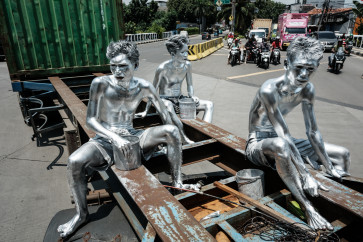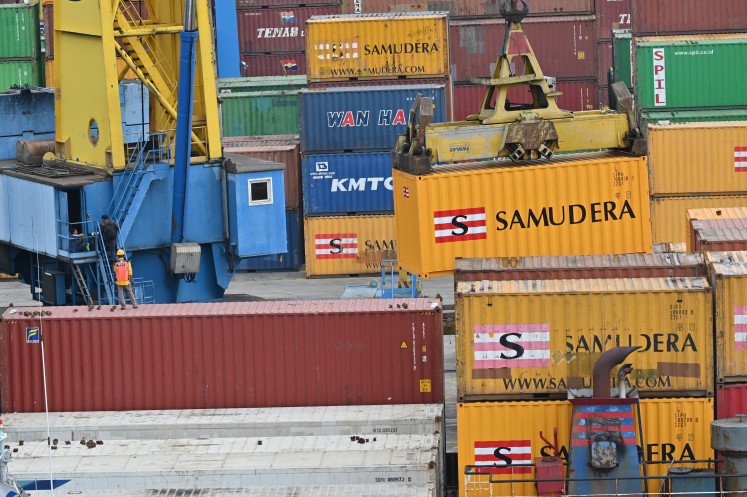Training orangutans in the wild
Baby steps: A trainer helps an orangutan adapt to its natural environment in Jantho in Aceh Besar
Change text size
Gift Premium Articles
to Anyone

B
span class="inline inline-center">Baby steps: A trainer helps an orangutan adapt to its natural environment in Jantho in Aceh Besar. Two modified jeeps were passing a steep hillside in the pine forest of Jantho, Aceh Besar, with roaring engines laboring along a high and muddy ascent. Each of the cars carried two iron cages with four orangutans.
The jeeps of the Sumatran Orangutan Conservation Program (SOCP) were on a mission to deliver the four orangutans to the orangutan quarantine center in Jantho recently.
“This road has purposely not been asphalted to prevent illegal loggers and hunters from entering this forest conservation zone,” said Asril, an SOCP staff member.
The four orangutans to be sent to Jantho came from the quarantine center in Batu Mbelin in Deli Serdang, North Sumatra, which is also managed by the SOCP. “As these orangutans are of Aceh origin, we’re releasing them in the Aceh forest,” Asril said.
It took about four hours to cover a distance of only 12 kilometers. The Jantho reserve quarantine was built in 2011 as a temporary accommodation center for Aceh’s orangutans seized from private individuals.
The area is a well-equipped complex that works to support the reintroduction of orangutans to nature. Normally these protected primates undergo fairly long training before their eventual release in the wild.
Apart from being a quarantine and reintroduction station, the location also functions as a research center to study orangutan behavior under SOCP staffers. Some personnel are in charge of watching over and training the orangutans in their natural environment.
“As they have been raised by men for a long time, the orangutans here are completely unfamiliar with living in the wild,” said Damson Siahaan, an orangutan trainer. He said he had gotten very close to the animals he had handled so far, occasionally even treating them like his own children.
“We should treat them with tender loving care,” said Damson, who has trained orangutans for over nine years. He previously worked with the orangutan rehabilitation center in Bukit Tigapuluh National Park in Jambi. His dedication as a trainer led to his assignment to the Jantho reserve.

“They will likely be unable to survive in nature if they’re just released without proper training to get back to the wilderness,” Damson cautioned. It takes one to three months to train an orangutan so that it is adapted back to nature. In the process of reintroduction, the animals are monitored and fed before they are able to seek fruit on their own.
“When tame orangutans are already able to live independently, they mostly won’t return to the quarantine center and will gradually join the wild ones in their natural habitat,” noted Damson.
Besides those confiscated from private collectors, the orangutans handled by SOCP are also obtained from evacuations after their habitats are destroyed by forest conversion into oil palm estates.
“When reclaiming land for oil palm estates, their owners sometimes don’t care about the presence of wild animals like orangutans,” said Ian Singleton, director of SOCP.
One of the zones severely damaged, consequently destroying orangutan habitats, is Rawa Tripa in Southwest Aceh. The reclamation by burning forestland has caused many orangutans to be trapped amid ravaged marshes. “We’ve several times evacuated orangutans with injuries from this area,” Singleton said.
Before building the Jantho reserve orangutan release station, the SOCP released all the seized orangutans in Bukit Tigapuluh National Park in Jambi in cooperation with the Frankfurt Zoological Society (FZS) in Germany. A total of 150 orangutans have been released since 2003.
With the new reintroduction station in Aceh, all the orangutans found in Aceh province will be returned to the Aceh forest.

“We’ve managed to release 34 orangutans in the wild since March 2011,” said Singleton.
Orangutans (pongo abelii, pygmaeus) are rare and protected primates living in the forest zones of Sumatra and Kalimantan. Based on data from the Orangutan Information Center, their population is estimated at less than 30,000 in the two regions, with wild orangutans in Sumatra numbering between 6,500 and 7,500, and in Kalimantan between 12,000 and 13,000.
- Photos by JP/Hotli Simanjuntak









